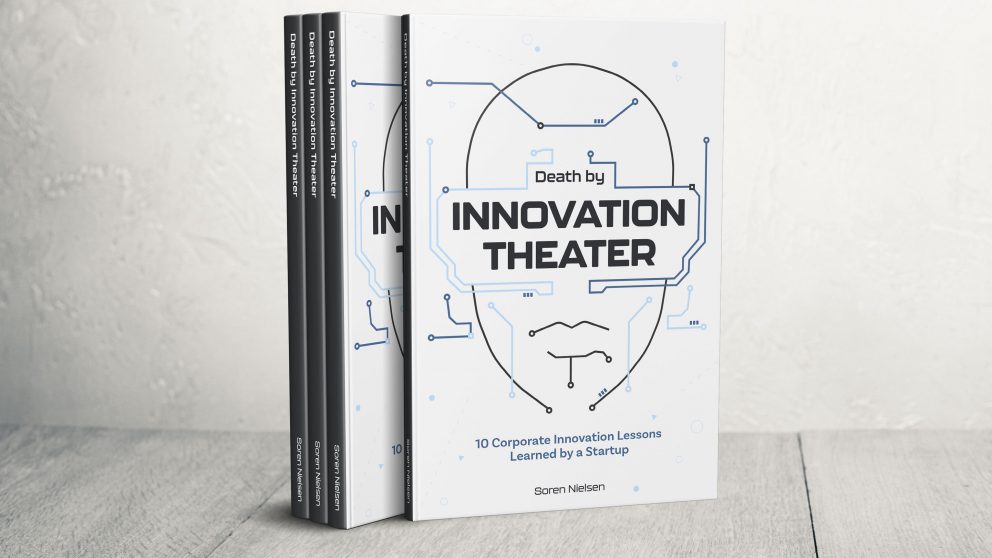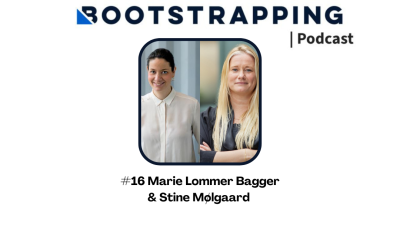
Søren Nielsen – Stay away from innovation islands
As CEO of ERNIT, a fintech startup, Søren Nielsen received several awards, media attention and funding. Nevertheless, Søren Nielsen turned the key in 2020 after five years of hard work, putting "innovation theater" as the biggest reason. By taking the reader behind the scenes of innovation theater "without all the glamour and bullshit that also revolves around the startup atmosphere" as it is put in preface of the book, "Death by innovation theater" is written to tell how a startup can avoid the same fate as ERNIT. Here we bring you chapter 3: Stay away from innovation islands.
The innovation theater pattern
This was a complete waste of time. I had just finished my third speed dating interview of twenty-five minutes with one of the representatives from the big local bank, and now it dawned on me. They were all juniors or had just been hired. All of the bank’s representatives at the event had no decision power, and the one that I had just talked to from risk had been at the bank for less than a month.
I found the table number for my next speed interview and sat down totally disillusioned. Should I make a run for it? Should I make a scene? Who was I going to entertain with a bit of innovation theater at this table? My next date didn’t show, and the organizers told me that he wasn’t coming for the event, because he had urgent matters elsewhere. “Urgent matters elsewhere” was code for “this is not important.” It left me with twenty-five minutes before my next interview. Twenty-five minutes to think. Why was I here?
I had driven seven hours the night before by car from the southern part of Denmark to Eindhoven in the Netherlands. The connecting flights from Denmark were bad, and taking the car was the cheapest option anyway. Cheapest often wins in a startup. At least when you are short on cash, which you often are in the early stages. Especially if it doesn’t have to do with the product. I remember that I really spent a lot of time analyzing if I should go to the event or not. Like always I was flattered when I saw the invitation from the bank to come to the two-day event, but I was starting to notice the innovation theater pattern. So I called one of my mentors. He said that I should only go if I could get the organizers to tell me more about who was attending the event. Was it people with decision power? Were people besides innovation and business development attending? What kind of budget were they looking at spending? I called the organizers. It was a separate consultancy agency that was hired for the task by the bank. I asked them all the questions I could think of. They said that they could not disclose the names of the attendees, but they could assure me that there were people from top management from all the different divisions coming. This was an event that would define the bank’s innovative future. I remember that they pressed my vanity button even more. The organizer said that the bank specifically had chosen ERNIT to attend as they were looking into doing something within the children’s finance space. I talked to my mentor again. We both agreed that I should give it a shot. This sounded like a good event. Boy, was I wrong.
Looking back, one of the main issues was that it was a separate consultancy agency that was organizing the event. I’ve seen a lot of these pop up during the last couple of years. These are organizers that promise to do the scouting of startups for the corporates and facilitate all the meetings, so the corporates don’t have to spend time on it. This is by definition one of the issues with this approach. The corporate has to spend time on this if they want innovation to work. Sure they can get help for some of the processes like scouting, but I’ve seen too many corporations think that they can outsource all of it. This is like having a marketing department and a sales department that don’t work together. The marketing department just gets their bonus if they create a lead – who cares if it converts or not, because the sales department is too busy anyway with doing something completely different.
This also shows in the number of corporate accelerators that are created. These are programs running for up to three months where a corporate works together with a number of startups in an innovation framework. In the last few years more and more corporations have tried to build their own pipeline of innovation through an accelerator. Some have been built by the bank themselves.
Others have been built and run by consultants. The majority of them have failed. Sixty percent of them actually close down after just two years, which is shown in an analysis by CB Insights following over forty-three different corporate accelerator programs from 2016 to 2018. These numbers, however, don’t scare the corporates. New accelerators and innovation labs are still being launched every year.
Avoid innovation clowns
The biggest innovation theater happens when the corporates build the so-called innovation labs. The term innovation lab is not by itself doomed to make the innovation fail. But it does not work if this innovation department is put outside the corporate’s normal structure both physically and process-wise. I’ve presented at numerous events where the topic was how to make successful intrapreneurship, corporate innovation and partnerships between startups and corporates. I’ve been pulled into these types of panels again and again.
One of them stands very vividly in my memory. It was an early morning in March. It was still quite cold outside, which it is during that time of year in Denmark, so people were wearing scarves and big jackets as they came into the venue. The location was hip. Right at the harbor in a newly built prize-winning building – and in the lobby you could get your coffee from the building’s local barista. We were three people presenting and afterward debating on a panel. A fairly standard setup. One of the other presenters was the head of an innovation lab from one of Denmark’s biggest companies. So this wasn’t just some random person talking. The company had clearly put some money into the innovation lab with numerous employees. He talked about his background from a creative ad agency, how he had insisted on building the innovation unit in a Copenhagen office with whiteboards and colorful beanbags far away from the rest of the corporate structure. That he believed that to attract the right type of innovative and creative talent, he had to do it this way. He had to take it out of the corporates’ normal headquarters, because the rest of the organization was slow and too risk-averse – and he proudly proclaimed that “they,” meaning the rest of the organization, called him and his team the “innovation clowns.” The innovation clowns! Well, if you want to raise your own fun house, wear the red nose and make everybody laugh, then I guess it’s a good strategy. But such an attitude will never give innovation a place at the decision table. If the identity of the innovation lab employees only can be fueled by setting up new entities and disassociating themselves from the rest of the company, then it is going to fail. This means that you can only make innovation on a protected island and never get it to market, and thus never change or improve anything. If you’re a startup, avoid these types of innovation labs at all costs. Especially the ones that are placed far away from the other parts of the organization, have a totally different work environment than the rest of the company and that focus more on gathering new ideas rather than knowing how to integrate them. They will waste your time as the road to market will be never-ending.
Gabs between companies and innovation labs
We had our fair share of encounters with these innovation labs at ERNIT. One of them was with a big Finnish bank. Our encounter with this corporate was after a lot of learning from other potential partners. At this point we were aware that we shouldn’t spend too much time on these types of innovation labs. We steered clear of the ones that were clearly run by consultancy agencies, but this one in Finland was embedded into the bank. Or so we thought. After going through a weekend of selection processes where we had met with all the right senior people from all the different parts of the company and worked for days inside the headquarter building, we and two other companies were picked to be a part of the bank’s own accelerator program. We were happy. No wait, that’s an understatement. We were thrilled! This seemed like a perfect fit as the bank had put a lot of resources into it. We had worked inside the bank’s headquarters. Check. We had met with all the right senior people. Check. There was a process in place to move forward. Check. It wasn’t until our next meeting in Finland that we began to see the cracks. The first thing that made me worry was that we on this second trip were not going to the bank’s headquarters like the first time. This time it was an office space far away from the rest of the bank. The next thing was that none of the senior people were available anymore – everything was run by juniors, interns and even people that were still studying. So again this was not anchored inside the bank and absolutely nothing came out of the process for ERNIT.
The author of the book The Corporate Startup, Tendayi Viki, talks about the myth of the innovation lab. He suggests the reason for its failure starts at management. That oftentimes when innovation labs are created, they are created as a response to the assumption that some kind of innovative product will emerge from the innovation lab and save the company. There’s no innovation strategy. And once something successful comes from the innovation department, nobody knows how to implement it in the parent company. It’s like innovation labs often think that they are loved unconditionally by the rest of the company, and that the rules of stakeholder management don’t apply to them once they enter their island of colorful beanbags.
I remember one example of this with ERNIT when we worked with a big bank in Asia. We had conducted a technical pilot, where we had connected our system to the bank’s sandbox environment. It had been a painful road. But somehow we had hacked through the different processes. Yes, it was still only with dummy data in the sandbox environment, and we hadn’t moved outside of the innovation lab’s domain, but our contact person was happy. The company seemed happy as we met with some of the upper management and were also used as a good example of innovation in the public media after the first pilot. We had done most of the work from a distance, setting up meetings early in the morning Copenhagen time to accommodate for the time difference. Now it was time to make the transition from the innovation lab to the rest of the company. We talked to our contact person about the next steps, and I clearly remember one of his comments. He said that we had to be very careful about not disturbing the mothership in the next process. Not disturb the mothership! In other words he was going to try to slip us into the company without too many people noticing. Well, surprise, surprise this didn’t work. If you don’t have buy-in from others than the innovation lab, then it’s doomed to fail.
KEY TAKEAWAYS:
- Vet the people you are going to meet. Stay away from powerless employees.
- Be wary of consultancy agencies. The corporate can’t outsource innovation – it needs to be anchored within the organization.
- Don’t spend time on innovation departments that are separated physically and process-wise from the rest of the organization.
- Take innovation seriously. Don’t visit innovation departments that put creative and funny labels on themselves.
- Is management on board with more than just money? If not then forget about it.
- Let everybody know that innovation is going to disturb the mothership. This is not a hush-hush exercise.











Comments